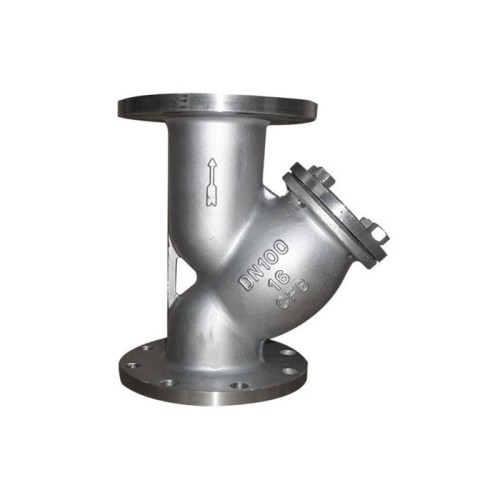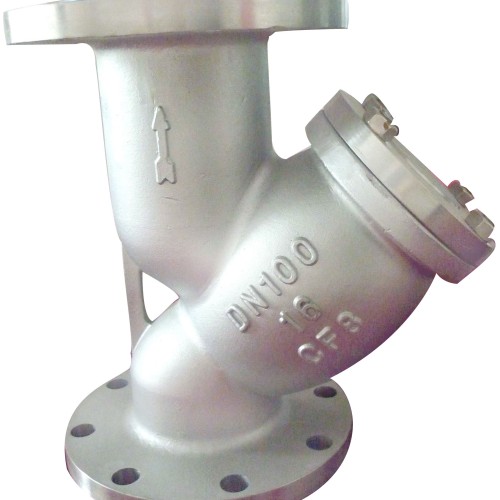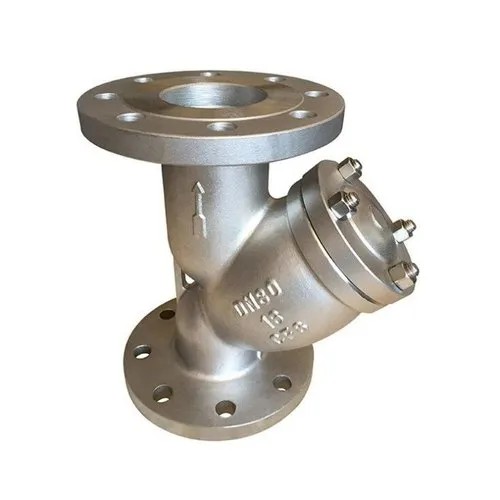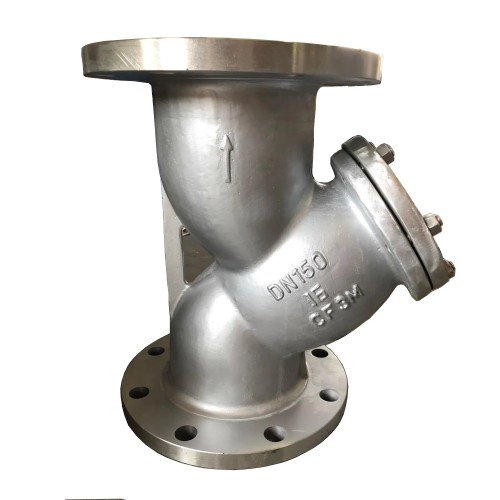Premium Stainless Steel Strainer - Durable & Efficient Filtration
Understanding the Critical Role of Stainless Steel Strainers in Industrial Filtration
In the realm of industrial fluid handling and process systems, the integrity and efficiency of operations are paramount, necessitating robust solutions for particulate removal. A stainless steel strainer stands as a cornerstone component, meticulously engineered to protect sensitive equipment such as pumps, valves, flow meters, and heat exchangers from potential damage caused by debris within pipelines. These critical devices, often configured as Y-strainers, basket strainers, or T-strainers, function by mechanically removing solids from liquid, gas, or steam lines, thereby preventing blockages, minimizing wear and tear, and ensuring optimal system performance. The choice of stainless steel, specifically grades like 304, 316, or 316L, is not arbitrary; it is driven by the material's exceptional attributes, including superior corrosion resistance, high tensile strength, and remarkable durability across a wide spectrum of operating temperatures and pressures. This makes them indispensable in environments ranging from aggressive chemical processing plants to municipal water treatment facilities, ensuring long-term reliability and reduced maintenance overheads. Their design often incorporates features like removable screens or perforated baskets, facilitating ease of cleaning and maintenance without significant disruption to the process flow. The GL41W-16 / 25P stainless steel strainer exemplifies this engineering excellence, designed to meet rigorous industrial demands, embodying the fusion of advanced material science and precision manufacturing that defines modern filtration technology.
The demand for high-performance filtration solutions continues to surge, driven by escalating industrial complexities and stringent environmental regulations. Current industry trends highlight a significant pivot towards more resilient, efficient, and maintainable filtration components, with the global industrial filtration market projected to reach USD 45 billion by 2028, growing at a CAGR of approximately 6% from 2021. Within this landscape, the segment of stainless steel strainer products, including specialized types like the stainless steel y strainer, is experiencing robust growth due to their inherent advantages over other material alternatives. End-users are increasingly prioritizing total cost of ownership (TCO) over initial acquisition costs, fostering a preference for products that offer extended operational life, minimal downtime, and superior resistance to process fluid contamination. This shift underscores the value proposition of a premium stainless strainer, which, despite a potentially higher upfront investment, delivers substantial long-term savings through reduced maintenance, extended equipment lifespan, and enhanced operational reliability. Furthermore, advancements in manufacturing processes, such as additive manufacturing for complex geometries and advanced surface treatments, are enabling the production of strainers with improved flow characteristics and filtration efficiencies. The continuous innovation in mesh design, material composites, and pressure rating capabilities ensures that these essential devices remain at the forefront of fluid purification technologies, adapting to evolving industry challenges and ever-more demanding application specifications across diverse sectors like petrochemicals, pharmaceuticals, food & beverage, and power generation.
The Advanced Manufacturing Process of Stainless Steel Strainers
The production of a high-quality stainless steel strainer, such as the GL41W-16 / 25P model, involves a meticulously orchestrated multi-stage manufacturing process designed to ensure structural integrity, precise filtration capabilities, and exceptional longevity. This complex journey begins with the careful selection of premium raw materials, primarily stainless steel grades like ASTM A351 CF8M (equivalent to SS316L for superior corrosion resistance, especially in chloride-rich environments) or ASTM A351 CF8 (SS304 for general applications), which are renowned for their strength and chemical inertness. The primary forming method for the body of robust strainers often utilizes investment casting or forging. Investment casting allows for the creation of intricate shapes with excellent surface finish and dimensional accuracy, minimizing the need for extensive post-processing machining, while forging enhances the material's grain structure, providing superior strength and ductility for high-pressure applications. Following the initial forming, subsequent stages include precise CNC machining to achieve exact flange dimensions, bore diameters, and screen housing tolerances, ensuring perfect alignment and sealing within the pipeline system. Welding processes, typically TIG (Tungsten Inert Gas) or MIG (Metal Inert Gas), are employed for assembling components like the screen housing to the main body, with strict adherence to AWS (American Welding Society) standards and qualified welders to prevent defects that could compromise pressure containment.

Beyond the core manufacturing, stringent quality control measures are integrated at every step to guarantee product reliability and compliance with international standards. Non-destructive testing (NDT) methods, including radiographic testing (RT) or ultrasonic testing (UT) for weld integrity, liquid penetrant inspection (LPI) for surface defects, and magnetic particle testing (MPT) for ferromagnetic materials, are routinely performed. Hydrostatic testing, where the strainer is subjected to pressures significantly higher than its rated operating pressure (e.g., 1.5 times nominal pressure as per ANSI/ASME B16.34 standards), is a critical final step to verify pressure boundary integrity and leak-tightness, ensuring safety and performance under operational stress. Material traceability is maintained throughout the process, from raw material receipt to final product shipment, via unique heat numbers and material test reports (MTRs), providing complete transparency and accountability. The average operational lifespan of a well-maintained stainless steel y strainer can exceed 20 years, depending on the application severity and fluid characteristics. These robust filtration units are widely deployed across a multitude of industries, including petrochemical (for crude oil, refined products), metallurgy (cooling water, lubrication systems), power generation (steam condensate, boiler feed water), and municipal water and wastewater treatment (preventing pump cavitation and pipeline fouling). In these demanding environments, the superior corrosion resistance of stainless steel ensures long-term protection against aggressive media, while its inherent strength withstands high pressures and temperatures, contributing significantly to energy efficiency by maintaining clean flow pathways and preventing pressure drops caused by clogged systems.
Technical Parameters and Performance Insights
Selecting the appropriate stainless steel strainer requires a comprehensive understanding of its technical parameters, which dictate its suitability for specific industrial applications. Key specifications for strainers like the GL41W-16 / 25P stainless steel strainer encompass nominal pipe size (NPS, or DN for metric systems), pressure rating (PN or Class), material of construction, end connections, and filtration mesh size. For instance, the "16 / 25P" in the product name signifies its pressure capabilities, typically referencing PN16 (1.6 MPa or 232 psi) and PN25 (2.5 MPa or 362 psi) for specific pressure classes, indicating suitability for medium to high-pressure systems. End connections are crucial for system integration, commonly featuring flanged ends (e.g., ANSI B16.5, DIN, JIS standards) for secure and leak-proof installation, or threaded/weld ends for smaller sizes or specific piping configurations. The material, often 316L stainless steel, is chosen for its superior resistance to pitting and crevice corrosion, particularly in environments containing chlorides or other aggressive chemicals, surpassing 304 stainless steel in such conditions. Furthermore, the mesh or perforation size of the straining element is a critical determinant of filtration efficiency, measured in microns or standard mesh numbers (e.g., 20 mesh for coarse filtration, 100 mesh for finer particles). This parameter directly impacts the particle size that can be removed, ensuring protection for downstream equipment.

To provide a clearer perspective on typical specifications, below is a table outlining common parameters for industrial stainless y strainer products, reflecting data gathered from various industry benchmarks and product standards. These values serve as a general guide, with actual product specifications varying based on manufacturer and specific model, such as the GL41W-16 / 25P. The temperature range, for instance, for 316L stainless steel can typically extend from cryogenic temperatures up to approximately 800°C (1472°F) for intermittent service, though specific pressure-temperature ratings will be defined by applicable standards like ASME B16.34. Flow characteristics, often measured by the Cv value (flow coefficient), indicate the volumetric flow rate of water at 60°F that will cause a pressure drop of 1 psi across the strainer. A higher Cv value indicates less resistance to flow and better energy efficiency. Pressure drop across the strainer is a critical performance indicator, influencing pump sizing and energy consumption; manufacturers aim to minimize this while maximizing filtration efficiency. Regular maintenance, including screen cleaning, is crucial to sustain optimal performance and prevent excessive pressure drops. Understanding these detailed parameters allows engineers and procurement specialists to make informed decisions, ensuring the selected stainless strainer precisely matches the operational requirements and environmental challenges of their industrial fluid systems.
Typical Stainless Steel Strainer Specifications Table
| Parameter | Typical Range/Value | Notes |
|---|---|---|
| Nominal Pipe Size (NPS / DN) | 1/2" to 24" (DN15 to DN600) | Larger sizes available for specific projects. |
| Pressure Rating | Class 150, 300, 600, 900, 1500 (PN16 to PN250) | Dependent on material and temperature. |
| Body Material | ASTM A351 CF8M (SS316L), CF8 (SS304) | Other alloys for specialized corrosive services. |
| Screen Material | 304 SS, 316 SS, Monel | Selected based on fluid compatibility and temperature. |
| Filtration Mesh Size | 20 to 200 Mesh (75 to 840 microns) | Custom sizes available for specific particle removal. |
| Temperature Range | -29°C to 450°C (-20°F to 842°F) | Specific range depends on pressure class and standard. |
| End Connections | Flanged (RF/FF), Threaded (NPT/BSP), Weld (BW/SW) | Based on piping system design. |
| Applicable Standards | ASME B16.34, API 609, EN 1092-1, ISO 9001 | Ensures quality, safety, and interchangeability. |
Applications and Strategic Advantages in Industrial Sectors
The versatility and robust performance of a stainless steel strainer make it an indispensable component across a broad spectrum of industrial applications, providing critical protection for sensitive downstream equipment. In the demanding petrochemical industry, for instance, stainless steel Y-strainers are routinely installed upstream of pumps, compressors, and control valves to filter out pipe scale, welding slag, and other solid contaminants from crude oil, refined products, and natural gas streams. This prevents costly equipment failures and maintains optimal flow dynamics, significantly contributing to operational efficiency and safety. Within power generation plants, particularly for steam and condensate lines, these strainers play a vital role in protecting turbines, heat exchangers, and boiler feed pumps from particulate matter, ensuring uninterrupted power supply and extending the lifespan of high-value assets. The inherent corrosion resistance of stainless steel is crucial here, preventing rust and degradation even in high-temperature, high-pressure steam environments. Furthermore, in the complex world of chemical processing, where aggressive and corrosive fluids are commonplace, the GL41W-16 / 25P stainless steel strainer, with its 316L material construction, offers unparalleled resistance to chemical attack, minimizing contamination risks and ensuring product purity, which is paramount in manufacturing pharmaceuticals or specialized chemicals.

Beyond these heavy industries, the utility of a stainless strainer extends to food and beverage processing, where hygienic design and ease of cleaning are paramount, and to municipal water treatment facilities, where they protect water pumps, disinfection systems, and reverse osmosis membranes from debris, ensuring the delivery of clean, safe water. A notable application case involves a major municipal water utility that implemented a series of large-diameter stainless steel y strainer units, leading to a documented 15% reduction in pump maintenance events and a 5% improvement in overall system pressure stability over two years, validating the long-term economic benefits. Compared to strainers made from carbon steel, which are susceptible to rust and require frequent painting or lining for corrosion protection, stainless steel variants offer a superior cost-benefit ratio over their lifecycle due to reduced maintenance, longer service intervals, and inherent durability in harsh conditions. While bronze or cast iron may suffice for certain non-corrosive applications, stainless steel's broad chemical compatibility and temperature range make it the material of choice for demanding industrial environments. The initial investment in a high-quality stainless steel unit is quickly offset by substantial operational savings, enhanced system reliability, and compliance with stringent industry regulations. Our commitment to delivering certified products, like the GL41W-16 / 25P, ensures that clients receive components that meet or exceed international standards, including ISO 9001 quality management systems and PED (Pressure Equipment Directive) certification for European markets, underscoring our authority and trustworthiness in the B2B sector.
Ensuring Trust and Reliability: Our Commitment to Quality and Support
At the core of our business philosophy is an unwavering commitment to trust and reliability, particularly when supplying critical components like the GL41W-16 / 25P stainless steel strainer to our global industrial clientele. We understand that for B2B decision-makers, product quality extends beyond mere specifications to encompass consistent performance, dependable supply chains, and robust after-sales support. Our manufacturing facilities are certified to ISO 9001:2015, affirming a comprehensive quality management system that governs every stage from design and material procurement to production and final inspection. This commitment is further demonstrated through our adherence to international standards such as ASME, ANSI, DIN, and JIS, ensuring that every stainless strainer we produce is globally compatible and meets the most rigorous performance benchmarks. We provide comprehensive material test reports (MTRs) for all critical components, along with hydrostatic test certificates, validating the integrity and safety of each unit shipped. Furthermore, our collaboration with major engineering, procurement, and construction (EPC) firms on large-scale infrastructure projects across Asia, Europe, and North America over the past two decades underscores our proven track record and authoritative standing in the industrial valve and strainer market, contributing to our overall credibility and expertise.

To address common inquiries and ensure complete transparency, we offer the following frequently asked questions (FAQs) and service assurances. Our standard delivery lead time for the GL41W-16 / 25P stainless steel y strainer typically ranges from 4 to 6 weeks for standard configurations, with customized or large-volume orders requiring 8 to 12 weeks, depending on complexity and material availability. Expedited options are available upon request for urgent project timelines. Each strainer comes with a comprehensive 18-month warranty from the date of shipment or 12 months from installation, whichever comes first, covering manufacturing defects and material failures under normal operating conditions. Our dedicated customer support team provides 24/7 technical assistance, including troubleshooting, installation guidance, and spare parts procurement, ensuring minimal downtime for your operations. Clients consistently report high satisfaction, citing the longevity and minimal maintenance requirements of our products. For instance, a recent client in the wastewater treatment sector praised our strainers for significantly reducing their annual pump repair costs by 20% due to effective debris capture and consistent flow. This blend of certified quality, transparent processes, and proactive customer service solidifies our position as a trusted partner for B2B procurement, reinforcing the reliability and value proposition of our stainless steel filtration solutions.
Frequently Asked Questions (FAQs)
Q1: What distinguishes a Y-strainer from a basket strainer?
A Y-strainer, characterized by its "Y" shape, is commonly used in pipelines that require continuous flow and where a small amount of solid removal is sufficient. Its compact design allows for installation in both horizontal and vertical pipelines, making it versatile for various applications, particularly in steam and gas lines where continuous draining of condensate or debris is critical. Basket strainers, conversely, are typically larger in capacity and are designed for applications with higher concentrations of solids or where less frequent cleaning is desired. They are installed in horizontal pipelines and offer a larger filtration area, making them ideal for water lines, oil lines, and chemical processes requiring higher flow rates and less frequent intervention. The choice between a stainless steel y strainer and a basket strainer depends on factors like flow rate, particulate load, space availability, and desired maintenance frequency.
Q2: How often should a stainless steel strainer screen be cleaned or replaced?
The frequency of cleaning or replacement for a stainless strainer screen is highly dependent on the nature of the fluid being processed, the concentration of solids, and the desired level of filtration. In systems with high particulate loads, cleaning may be required frequently, perhaps weekly or monthly, to prevent excessive pressure drop and maintain flow. For cleaner fluids, cleaning might only be necessary every few months or even annually. A significant indicator that a strainer requires servicing is a noticeable increase in pressure differential across the strainer, which signals that the screen is becoming clogged. Regular monitoring with pressure gauges installed upstream and downstream of the strainer is recommended. Additionally, visual inspection during routine system shutdowns will help determine the condition of the screen and identify any signs of wear, corrosion, or damage that would necessitate replacement. Proactive maintenance based on operational data is key to maximizing the lifespan and efficiency of the stainless steel strainer.
Q3: Can these strainers be customized for specific industrial requirements?
Yes, absolutely. While our GL41W-16 / 25P stainless steel strainer series offers robust standard configurations, we specialize in providing customized solutions to meet unique industrial requirements. Customization options often include specific material grades beyond standard 304 or 316L (e.g., Duplex, Super Duplex, or Hastelloy for extremely aggressive media), non-standard pressure ratings, specialized end connections to match existing piping systems, and highly specific mesh or perforation sizes to achieve precise filtration levels. We also offer various coating options for enhanced protection and different types of blow-off connections for in-situ cleaning. Our engineering team works closely with clients to understand their precise operational parameters, fluid characteristics, and space constraints, utilizing advanced CAD and simulation tools to design and manufacture bespoke strainers that integrate seamlessly into their systems and deliver optimized performance. This collaborative approach ensures that even the most challenging filtration needs are met with precision-engineered solutions.
Authoritative References
- American Society of Mechanical Engineers (ASME) B16.34 - Valves—Flanged, Threaded, and Welding End.
- International Organization for Standardization (ISO) 9001:2015 - Quality management systems — Requirements.
- ASTM International (ASTM) A351/A351M - Standard Specification for Castings, Austenitic, for Pressure-Containing Parts.
- Hydraulics Institute (HI) Standards - Pumps, Piping, and Valve Systems.
- Valve Manufacturers Association of America (VMA) - Valve Standards and Practices.
-
The Key to Fluid Control: Exploring the Advantages of Ball Valves in Industrial SystemsNewsJul.09,2025
-
The Versatile World of 1, 2, and 3 Piece Ball ValvesNewsJul.09,2025
-
Stainless Steel Ball Valves: The Ideal Choice for Efficient Flow ControlNewsJul.09,2025
-
Optimizing Fluid Control with Ball Float ValvesNewsJul.09,2025
-
Manual Gate Valves: Essential for Control and EfficiencyNewsJul.09,2025
-
Everything You Need to Know About Butterfly ValvesNewsJul.09,2025
-
The Versatility of Wafer Type Butterfly ValvesNewsJul.08,2025




